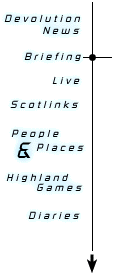
The Devolution Debate This Century
Immediately after the First World War home rule was supported by the Liberals and the burgeoning socialist movement. It was based on a desire for greater control of Scottish economic resources.By 1913 the shipyards of the Clyde estuary produced one-fifth of the world's total shipping. The country possessed a thriving industrial and agricultural economy which many Scots wanted to see harnessed to tackle poverty at home.
In 1919 a group of Conservative MPs requested a Speaker's Conference on devolution. Two reports emerged, both agreed that the assembly should have considerable revenue raising powers.
These schemes were overshadowed by the political crisis brought on by Ireland's determination to secure its independence from Britain and came to nothing. By the 1920s Home Rule had begun to seem unattainable.
The 1920s and 1930s were decades of alarming decay in Scotland. The Scots were hit harder by the Depression than the English and Welsh.
Although Labour was formally committed to home rule throughout the 1920s, over the following decade it gradually slipped down the party's list of priorities. This was emphasised when the pro-Home Rule Independent Labour Party split from the Labour Party in 1932.
There was a lot of popular support for constitutional change in Scotland. In 1932 The Scottish Daily Express ran a straw poll in 35,000 homes and found 113,000 people in favour of self-government and only 5,000 opposed.
However, Home Rule was not among the priorities of any of Britain's major political parties and the Scottish public were not willing to support parties which were exclusively devoted to home rule or independence - these parties were mostly weak and divided and contained their fair share of eccentric characters.
In 1947 a Scottish Convention was formed with the hope of securing a parliament for Scotland along non-party lines. Two years later, using the idea of the Presbyterian 'solemn league and covenant', it drew up the Scottish Covenant, which was eventually signed by two million people. However, it made little impact as all the Westminster parties still kept devolution off the main parliamentary agenda leaving the Covenant movement with nowhere to go.
The Scottish National Party (SNP) was one party devoted to radical constitutional change for Scotland. It was formed in 1934 through an amalgamation of the National Party of Scotland and the Scottish Party - a breakaway section of the Cathcart Conservative Association.
It won its first seat in Motherwell in 1945 under the war time convention under which the Conservative, Labour and Liberal parties agreed not to contest by-elections.

|
| The Stone of Scone, seized by nationalists |
The party's first major breakthrough did not come until 1967, when Winnie Ewing won a by-election in the normally solidly Labour seat of Hamilton.
The Growth of Nationalism

|
| Margaret Ewing won the safe Hamilton seat for the SNP in 1967 |
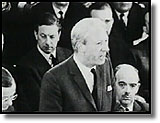
|
| Edward Heath declares his support for devolution at Perth in 1968 |
The discovery of North Sea oil in 1970 increased momentum and support for nationalism and hence devolution, as the SNP now seemed to possess a highly attractive political formula - independence and the Saudi-type oil riches that could accompany it.
The promise of oil revenues removed many of the economic fears associated with secession. At the 1970 General Election the SNP's share of the vote rose to 11.4%. This new high was put in the shade when in the two elections of 1974 the SNP polled 21.9% of the popular vote in February and 30.4% in October. The party won seven and eleven seats respectively.
Labour's conversion to devolution came a little later and was slightly more problematical. In 1970 a report was commissioned to look into constitutional reform for Scotland. The Kilbrandon Royal Commission reported three years later with recommendations for a Scottish assembly which were not greeted with much enthusiasm by Scottish Labour.
The sharp rise in nationalist support, which registered in the first of the two general elections of 1974, prompted the Labour Prime Minister, Harold Wilson, to make a commitment to devolution.
On June 22 Labour's Scottish executive met to ratify the Downing Street proposals on devolution. Unfortunately this was also the day of the Scotland V Yugoslavia World Cup football match and only 11 members turned up. Most of those who stayed away to watch the football were pro-devolution. This gave the anti-devolutionists their chance to throw out the proposals.
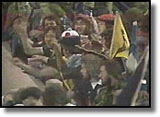
|
| They should have been at the committee . . . |
In the General Election of October, which Labour narrowly won, the SNP won 11 seats and ran second to Labour in 33 constituencies. A devolution Bill was introduced in 1977 by the Callaghan government but failed.
The excellent performance of the SNP in district council elections in May reminded Labour that they could not sit back and a second Bill was introduced in November. Included in this Bill was the '40 per cent rule' or 'Cunningham amendment', stating that if less than 40% of the electorate voted 'Yes', then the Scotland Act granting devolution should be repealed.
The 1979 Referendum
By March 1979 the public was bored by the issue of devolution. Labour was split between devolutionists and unionists while the SNP was split between devolutionists and those who favoured complete independence.
The sponsors of the devolution legislation were tired after the five-year struggle and although the 'No' campaign was just as divided, they were more energetic and direct in their opposition.
The debate revolved around the 'West Lothian question' - the question put by the Labour MP for the area, Tam Dalyell. Why, he argued, should Scottish MPs be allowed to vote on English matters at Westminster while English MPs would have no right to intervene in Scottish matters if there was a Scottish Parliament?. The debate highlighted the potential for conflict between the proposed new body and Westminster, which, unionists argued, would lead to total independence.
Economics was also a major factor as many people doubted in such a turbulent economic period Scotland should remove itself in any way from the security of a larger entity. Andrew Marr, in his book 'The Battle for Scotland', sums up the period well:
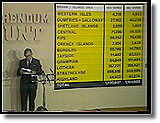
|
| In 1979 the Scottish people said "Yes" but in insufficient numbers |
1.23 million Scots voted for and 1.15 million voted against a Scottish assembly. The turnout was 63.8% but the Yes vote represented only 32.9% of the electorate and thus devolution for Scotland fell before the Cunningham amendment.
Towards the Convention
The Campaign for a Scottish Assembly was launched by home rule politicians, academics and activists in the immediate aftermath of the 1979 defeat in order to continue the fight.The early eighties were a barren time for them but after the Conservative victory in the 1987 General Election the idea of cross party support for a devolved Scottish Assembly began to seem attractive.
Scotland had rejected Thatcherism and the number of Tory MPs was cut to a then all time low of 10. Labour had looked on impotently as the hated Poll Tax was pushed through in Scotland and the factories, shipyards and steel mills, symbols of Scotland's industrial might, closed down one by one. London government began to seem alien.
In March 1989 the Scottish Constitutional Convention held its inaugural meeting. It was made up of 58 of Scotland's 72 MPs, 7 of its 8 MEPS, 59 of its 65 councils and representatives of various groups such as the Scottish Trade Union Congress and various Churches.
The SNP had dramatically pulled out but the Convention worked on with Labour and Liberal Democrat support. The Conservatives were opposed. The Convention travelled throughout the country and on November 30, 1990, an agreement on the form a Scottish assembly should take was signed. This was followed by a hard won commitment from Labour to PR for such a body, in time for the 1992 General Election.

|
| Canon Kenyon Wright warns Margaret Thatcher at the Constitutional Convention |
|
|
| Canon Kenyon Wright voicing Scotland's concerns |
1992 and After
The closure of Ravenscraig and Rosyth in favour of respective sites in more politically marginal areas of England and Wales were seen as further confirmation of how the Westminster government did not have Scotland's best interests at heart.
The Constitutional Convention continued to meet, having successfully united the middle ground, it patiently made plans and bided its time. In 1995 it produced a blueprint for a Scottish parliament, Scotland's Parliament, Scotland's Right.
The summer of 1996 was spent discussing the form of the ballot paper with Labour moving between the idea of having one or two questions. The latter was adopted and, for the 1997 election campaign, devolution was once again high up on the agenda of all the political parties.
The Conservatives campaigned vigorously against devolution. They feared it would lead to eventual Scottish independence and the break-up of the United Kingdom. They used the issue of the 'Tartan Tax' as the centre-piece of their campaign.
The Tories argued that higher rates of taxation would result if Scotland was given its own parliament. Conservative opposition to devolution was faced with a united pro-devolution stance from Labour and the Liberal Democrats.
These two parties issued a statement in March 1997 stating they would support each other on the issue of devolution for Scotland and Wales. The SNP, as we have seen, took no part in the Scottish Constitutional Convention and campaigned for a third question, that of independence, to be included on any referendum ballot paper. Since this was not realised, they moved slowly towards supporting the double 'Yes' vote.
The total defeat of the Conservatives in Scotland on May 1 has left the party formally still campaigning on the same theme as it did before the election. However, it remains unclear which direction Scottish Conservatives will eventually take if Scotland votes 'Yes'.
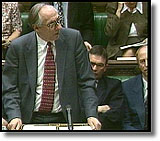
|
| Donald Dewar announces the White Paper |
Labour has wasted no time on devolution since coming to power. The party in Scotland is unified on the issue, with Tam Dalyell, the man who originally posed the West Lothian question, still the only publicly outspoken MP against the proposals. A Referendums Bill for Scotland and Wales was published on May 15 followed by the White Paper on July 24. The date for the Scottish Referendum was set for September 11.
Early Scottish History and the Union

